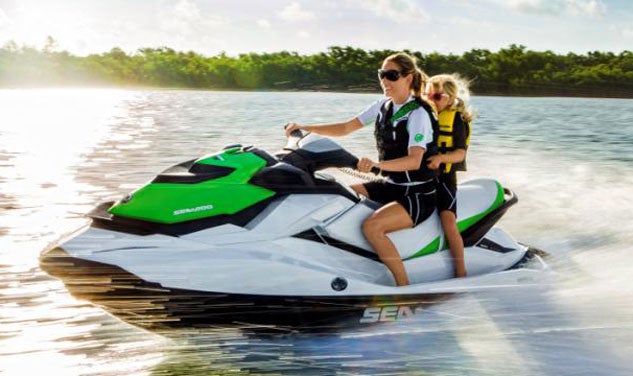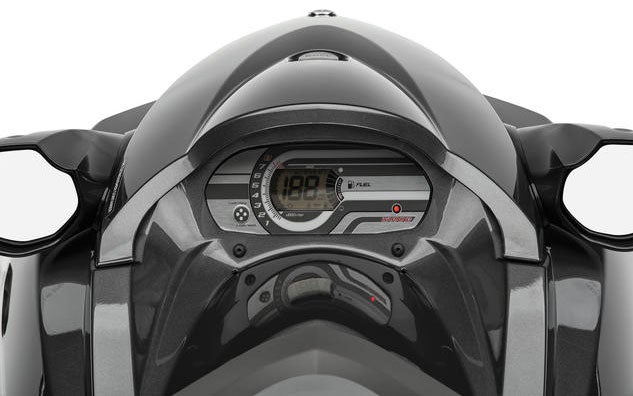Kawasaki STX-15F vs. Sea-Doo GTS 130 vs. Yamaha VX Sport
Entry level personal watercraft comparison
Sea-Doo’s Spark is generating plenty of buzz, but while it certainly has its place, many buyers will be better served by stepping up to a true, three-passenger introductory model. They’re roomier, handle big water conditions far better, offer more power and features, and make for easier towing.
But how do the first steps in each manufacturer’s introductory line match up? Here are a few points of comparison between the Kawasaki STX-15-F, Sea-Doo GTS 130 and Yamaha VX Sport.
The Specs
For starters, all three models are legitimate three-passenger craft. They have the length, the stability, and the seat room to handle two in total comfort, and add a younger passenger when desired. Three adults is certainly possible, but chances are you won’t make it a regular thing.
 At 132.6″ long, the Sea-Doo GTS 130 is the longest of the entry-level watercraft.
At 132.6″ long, the Sea-Doo GTS 130 is the longest of the entry-level watercraft.As to the exact tale of the tape, the Sea-Doo is the longest at 132.6”, followed by the Yamaha at 126.8” and the Kawasaki at 122.8”. Differences in width are minimal, but weight bears noting. Here the Yamaha tips the scales at 736 pounds, the Sea-Doo measures up at 780, and the Kawasaki weighs 844.5.
COMPARISON: Read our review of the 2014 Kawasaki Jet Ski STX-15F
In terms of fuel capacity, Yamaha leads the way at 18.5, followed by Kawasaki at 16.4, and Sea-Doo at 15.9. Given that the Yamaha is also the least powerful engine of the three, that should also translate into the VX Sport having the greatest range of all three craft. In terms of storage, Sea-Doo leads the way at 30.8 gallons of total capacity, followed by Kawasaki at 23.5 gallons, and Yamaha at 15.1.
Features
The GTS is the one Sea-Doo model that doesn’t offer Intelligent Brake and Reverse, so Kawasaki is the lone manufacturer to offer reverse at this level. That will make a difference, especially for new riders, around docks or launch ramps as it allows an added level of control. Riders can use the reverse to effectively hold the craft in position or back away without surprises. On both the Yamaha and the Sea-Doo, it’s back to old-school “always-on” thrust, meaning you’ll have to take an added measure of care in tight confines and learn how to come into the dock or shore with care and your finger poised atop the stop button.
Kawasaki is also a notch up the ladder in other ways. Its seat is a two-parter, and the STX also offers a spring-loaded boarding step. Kawasaki also offers an impressive info display, one of the many indications that this was once a flagship craft that has simply trickled down over the years. Sea-Doo’s info display is likewise full-featured, while Yamaha’s takes a more minimal approach. The Sea-Doo’s saddle is also nicely sculpted and bolstered, with a tiered approach to make the ride more pleasant for passengers. Kawasaki’s and Yamaha’s saddles are a notch below, but still offer some bolstered support and structure to keep drivers and passengers in place and comfortable.
 Yamaha takes a minimal approach with the VX Sport dash.
Yamaha takes a minimal approach with the VX Sport dash.Sea-Doo holds a clear edge in power management. The GTS offers two, user-selectable acceleration modes. Those looking to keep things a little calmer can choose Touring mode to soften the boat’s response. Those looking for the full potential of the engine can opt for Sport mode, which features a more-aggressive acceleration curve. A third mode, ECO, lets the computer decide on the most fuel-efficient approach and govern throttle accordingly.
Power
The clear difference between the models is in terms of power, and as we’ll see shortly, price.
COMPARISON: Read our review of the 2014 Yamaha VX Sport
Kawasaki is far and away the leader in terms of acceleration and handling. Reporting horsepower has fallen out of style due to manufacturers measuring it in different ways and taking advantage of marketing tricks that allow them to sometimes boost actual numbers. Still, those sometimes dead-on, sometimes ballpark numbers remain a source of rough comparison.
 With 160 horsepower on tap, the Jet Ski STX-15F is far and away the most powerful entry level craft.
With 160 horsepower on tap, the Jet Ski STX-15F is far and away the most powerful entry level craft.Kawasaki’s 160hp engine is, again, reflective of the fact that it was once a premier model. Its 1,498cc will push the STX-15F to about 62 mph, far ahead of the competition, and produce plenty of thrust to pull even your bigger tow-sports enthusiasts out of the water. Sea-Doo comes in closer to 130 hp. That’s enough to produce about a 55 mph top speed, and again, enough acceleration to pull skiers, wakeboarders, wakeskaters, etc. Yamaha’s VX Sport measures up at closer to 110 horsepower, and typically tops out around 52-54 mph. It, too, features enough power to haul tow types, but as you might expect, the job gets just a little tougher as you descend through each horsepower range.
Handling
Each boat displays a confident, stable nature on the water. In other words, I would entrust my family to any of the three. They can handle anything from glass to moderate ocean chop, and avoid most of the quirks that could cause newcomers any moments of anxiety. The Kawasaki at times feels a little lower slung than the others, but that’s something that will fall to rider preference.
 All three craft in this class are stable on the water.
All three craft in this class are stable on the water.At the opposite end of the spectrum, when it comes to carving a high-speed turn the Kawasaki is the most aggressive handling model by far. Its hull was developed originally for the race course, and it carves a precise, tight turn that may surprise the newcomer with its tenacity. On the other hand, it has the most potential to grow with an enthusiast should they develop a more aggressive riding style. Both Yamaha and Sea-Doo display tamer manners, with the Yamaha falling somewhere in the middle and the Sea-Doo purposely offering a little more of the old-school looseness that makes it the most playful feeling of the three.
Price
As the saying goes, you get what you pay for. And it’s here, in terms of price, that the differences mentioned above translate to what you see on the price tag when you walk into your dealer’s showroom.
COMPARISON: Read our review of the 2013 Sea-Doo GTS 130
At $9,699, the Kawasaki is by the most expensive model of the three, a full $1,500 higher than the nearest competitor. Kawasaki somewhat justifies this price with clearly superior power and handling. Still, a price close to $10,000 is a lot of money for the entry-level buyer. Sea-Doo’s $8,199 price for the GTS 130 is perhaps more in line with an introductory model, and is backed up by some nice extras, including the aforementioned electronic throttle control options and the greatest storage capacity of any of the three. At only $7,999, the Yamaha remains the most attractively priced of the three models, and the VX line’s continual position as the industry’s number-one seller is a testament to Yamaha’s reliability. Yes, it’s the most bare-bones model in terms of features and the lowest in power, but it knows its role and does it well.
 Class-leading power and handling come at a cost as the Jet Ski STX-15F is $1,500 more than the other two craft.
Class-leading power and handling come at a cost as the Jet Ski STX-15F is $1,500 more than the other two craft.The question that remains is which boat is the best for you. Suggestion? Consider your budget, take a look at your water conditions and how you most often like to ride, think carefully about the level of control and power you desire from your craft…and then, if at all possible, take a test ride.
You can’t go wrong with any of the three…but one will clearly be the right choice for you.
Get PersonalWatercraft.com in your Inbox!
Like PersonalWatercraft.com on Facebook
Comments
Most Popular

2025 Yamaha JetBlaster PRO 2-Up Review

Remembering the Sea-Doo XP

2024 Kawasaki Jet Ski STX 160X Review

2017 Kawasaki Jet Ski Ultra 310LX Review

2024 Yamaha GP HO Review













 Your Privacy Choices
Your Privacy Choices